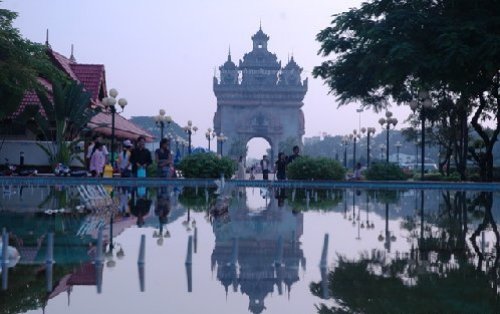Trade Dividend Elusive In Laos
The inclusive growth that policymakers in Laos are striving for is not likely to happen in the early stages of trade liberalisation because income distribution remains so unequal between urban and rural areas, says an academic.
The country is expected to take at least a decade to experience concrete benefits from trade liberalisation and World Trade Organization (WTO) membership as it gradually becomes more attractive for foreign direct investment (FDI), said Phouphet Kyophilavong, research director of the Faculty of Economics and Business Management at the National University of Laos.
So far, he said, trade liberalisation appeared to be having more negative than positive impacts. Urban areas, notably the capital Vientiane, are benefiting the most, while the majority pursuing agricultural livelihoods in the rural hinterland face potential threats.
Laos became the WTO’s 158th member in February after a negotiation and accession process that took 15 years.
Mr Phouphet believes his country will benefit from trade liberalisation and WTO membership but not right away. “It may take time, probably 10 years, to see the positive results from those economic changes,” he said.
He noted that as a member of Asean, Laos was already a party to the regional free trade agreement and other pacts between Asean and partners including China and India. Asean is also considering a trade agreement with the European Union. However, Laos is the poorest country in Southeast Asia, and other than the electricity from its abundant hydropower sources that is sold to Thailand, it has little to export.
“Trade liberalisation will increase the trade deficit for two reasons. First, Laos does not produce a diverse range of goods. Besides minerals and electricity, Laos exports a few other commodities such as clothes, coffee and a few crops,” Mr Phouphet wrote in a research paper published in December 2011. “Second, some of Laos’s exported goods are not competitive in the world market but are propped up by preferential [tariff] treatment.”
The paper, entitled “Impact of Trade Liberalisation on Pollution and Poverty in Lao PDR”, forecasts changes in carbon dioxide levels based on increased investment in resource extraction and industry as the economy opens up.
In looking at poverty, the paper focused on four dimensions: consumer prices, producer prices, wages, and spending and income.
“Only people in Vientiane and urban areas are benefiting from increasing trade volume and new investment coming to the country,” he said. “Trade liberalisation so far has failed to distribute benefits to people living in the remote areas.
“Those people are in the agricultural sector and Laos is importing more agricultural products — meat, fruits and vegetables — from neighbouring countries. So, the domestic agricultural sector of the country is being hurt by the increasing imports.”
According to his study, which used 2004 as a base year, export volume was forecast to grow by an average of 0.93% per year but import volumes would rise at a faster rate of 5.65%.
“Since Laos opened up to trade, imports of pork, fruits and vegetables from Thailand have been increasing. So I think that we will face trade deficit for the years ahead,” he said.
According to World Bank estimates, exports from Laos last year were worth US$2.84 billion, while imports were worth $4.16 billion, producing a trade deficit of $1.32 billion. FDI increased to $1.62 billion from $1.13 billion in 2011.
China, Thailand and Vietnam accounted for nearly 80% of the goods imported by Laos and bought 70% of its exports in 2011. The same three countries accounted for about 60% of all FDI in the country in 2010.
Mr Phouphet said that as more agricultural and industrial products entered the country because of reduced import tariffs, incomes in the two sectors would drop. The declines are very small in agriculture, at less than 0.1%. But in the industrial sector, processed food would face a heavy negative impact, followed by heavy manufacturing with a 3.27% drop.
Gainers from trade liberalisation, he said, would be utilities and construction, transport and communication, textiles and clothing, and other services sectors.
With wages far lower than in Vietnam and Thailand, Laos has the potential to attract more FDI but it needs to develop more infrastructure as well as worker skills to support manufacturing and other activities.
“Laos will face a negative impact in the short term, but I do believe that the country will benefit in the long term once FDI increases,” said Mr Phouphet.
Dr Nessara Sukpanich, an economics lecturer at Thammasat University, said the Communist government has acknowledged the importance of FDI to help develop the country. It recently combined the domestic and foreign investment laws into one to create a level playing field for both groups.
She said the main reason that the landlocked country was attractive for foreign investors was not its market of 6.5 million people, but the opportunity to export to developed markets that offer preferential import tariffs to poor countries. Laos is a beneficiary of the Generalised System of Preferences (GSP) for exports to the European Union.
Thailand has been known mainly as a big investor in hydropower projects in Laos, but Thai businesses have begun investing in agricultural ventures as the country has ample arable land. However, some barriers remain. Thai investors have to teach Lao farmers how to grow crops such as sugarcane and coffee.
In the industrial sector, although the benefit of low wage costs is a strength, whether Laos can provide enough qualified workers remains a challenge.
Source: Bangkok Post

